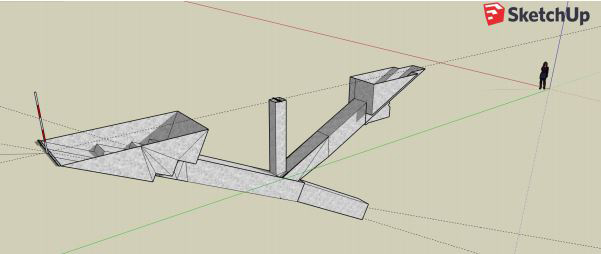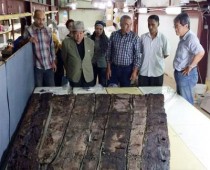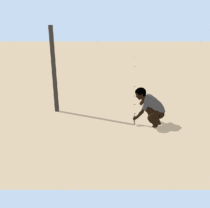A theory on the Great Pyramid’s Trial Passages sees the enigmatic structures as made to facilitate the iconic monument’s symbolic astronomical alignment. The theory has been presented by Dr. David Ian Lightbody, an expert in ancient architecture in a recent article published in the Journal of Ancient Egyptian Architecture.
The structures known as Trial Passages are a set of connected tunnels carved into the bedrock 87.5m from the east side of the Great Pyramid of Khufu, in the Giza plateau. At the same time, the structures’ system is located to the N. side of the causeway connecting Khufu’s mortuary Temple and his (now lost) Valley Temple. The “passages” have the form of three rectangular openings leading to a set of sloping passages with rectangular sections. Together, these shafts stretch approximately 23m in length horizontally in a north-south orientation and reach down to a depth of approximately 10m.
All archaeologists who have surveyed the Trial Passages through the years agree in dating the shafts around the time of the Great Pyramid’s construction. Several have also noted a similarity in form between them and the descending and ascending passages of the Pyramid itself with regards to inclination, width, and alignment on a North-South axis.
Still, these rock-carved structures have been interpreted in various ways over the decades. One of their earliest surveyors, the great W.M. Flinders Petrie interpreted them as some sort of replica or trial version of the internal passages within the Great Pyramid; hence the name Trial Passages. Other scholars have suggested that the Trial Passages were intended as shafts leading into a smaller pyramid which was removed later. Still, there is little evidence to support such theories and the possibility remains that the Trial Passages did not have any “trial”-related use.
Still, Petrie had observed that the inclinations of the north-facing passages in the Great Pyramid could have been associated with efforts to observe the northern stars. Glenn Dash, another surveyor, added to that theory; he suggested that an observation device could have been incorporated into those shafts to aid the orientation of the architecture. He was also able to describe it.
The above observations led Lightbody to establish his own theory on the Passages as designed and intended to be used to establish an accurate, astronomy-based, north-south alignment for the construction of the Great Pyramid.
“In the new hypothesis set out here, it is suggested that the Trial Passages were in fact designed to carry out accurate observations of the circumpolar stars in advance of the construction of the Great Pyramid”, explains Lightbody in his article ‘Moving heaven and earth for Khufu: Were the Trial Passages at Giza components of a rudimentary stellar observatory?’ (JAEA 4 (2020), p. 29-53). He also states that observation devices of the type described by Dash were installed within the Passages.
In detail, Lightbody starts with accepting that the alignment procedures carried out at Giza made use of the Trial Passages to the east of the Great Pyramid to observe the stars around the North Celestial Pole over a prolonged period of time. The observations were then used to establish an accurate north-south surveying reference line for the Giza plateau. If valid, this new hypothesis lends support to arguments contending that the stars were used in the architectural orientation procedures at Giza.
The use of stars as a means to align monuments in the ancient world in general, and Giza’s Pyramids in particular, as well as the symbolic reasons for that, have been widely discussed and is well documented. More specifically, discussions of the astronomical methods employed at Giza have usually revolved around the constellations close to the Northern Celestial Pole (NCP) and how these were used to determine the NCP’s location in the northern sky and by extension the direction of true north on the ground.
The NCP was not marked by any particular visible astronomical object in the Old Kingdom, and it is not today either. Still, it is possible to determine the NCP at the time the Great Pyramid was built through the closest bright star circling it, which was Thuban (α Draconis) – in a way today the NCP is mostly closely orbited by Polaris (α Ursae Minoris). Based on the architectural surveys so far, it is suggested that the ancient Egyptians were able to achieve that task with an accuracy of better than 1/15th of a single degree. However, the way they did so is poorly recorded.
In his research, Lightbody used a 3D model to accurately document the geometry of the Trial Passages structure. The model was built using the 3D CAD software Google/Trimble’s Sketchup version 2019-06-21.2, using dimensions based on a detailed survey of the passages carried out by Flinders Petrie in 1882-3, as they were proved to be accurate. The orientation of the main axis of the passages was also taken from Petrie’s survey.
Then, the researcher had to determine which stars would have been visible from the passages when looking north at the time the Great Pyramid was built. To do so he used the Stellarium 0.13.3 digital planetarium software, simulating the skyscape visible from Giza (by setting the location to that of Giza and by backtracking the system date to 2,590 B.C); the view produced was then built into the Trial Passages model.
Βy simulating the environment through the model, it was demonstrated that it could be possible for the Egyptians to establish a horizontal line on the surface that deviated by less than 1/15th of a single degree from true north, using the rudimentary method described and the rock-cut structure.
“The observations would have culminated with the positioning of two moveable targets, between which a mark would have been created that defined the east-west position of the point P2 on the surface. Any positional offset measured would have been translated to the surface using cubits and a long plumb line hanging down the central vertical shaft. The model showed that an offset of nearly 1 palm east from the centerline of the Trial Passage’s architecture would have produced a final alignment equal to that observed in the survey of the Great Pyramid’s base perimeter, once points (P1) and (P2) were connected”, states Lightbody.
Then, once the main alignment line was established, it would have been possible to accurately extend the line to the north and south with simple surveying techniques. It is stated however that it would be more difficult to do so for east and west, a task necessary to define the pyramid’s east side which lay 87.5 m to the west. This could be achieved by more complex and on-time observations by the workmen which, at the same time, were based on establishing the orientation of the NCP through the Trial Passages.
“There is no suggestion that this interpretation is definitive in any way, but it should prove interesting food for thought for the many scholars who remain intrigued by the early developments in the exact sciences made at Giza”, notes Lightbody.





